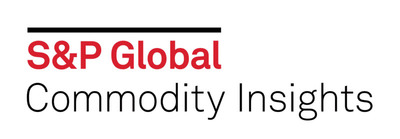Methane Emissions Intensity of Permian Basin Declined by More than Half in Two Years, New S&P Global Commodity Insights Analysis Finds
Werte in diesem Artikel
New analysis provides the most accurate public, basin-wide estimate of methane emissions for the Permian
HOUSTON, July 24, 2025 /PRNewswire/ -- The methane intensity of oil and gas production in the Permian Basin—an area responsible for half of U.S. oil production and one fifth of natural gas—declined by more than 50% during the 2022-2024 period as improved operations, better equipment and the utilization of AI and other advanced technologies led to reductions across all observable plume rates (large and small), according to a new analysis by S&P Global Commodity Insights.
The latest data for the year 2024 show the methane emissions intensity of upstream oil and gas operations in the region to be 0.44% per barrel of oil equivalent—a 29% reduction from the previous year.
Absolute annual 2024 methane emissions decreased by 21.3 billion cubic feet (bcf), a 22% decline from the previous year. Given that methane is a potent greenhouse gas, the reduction was equivalent to 11.1 million tons of carbon dioxide emissions avoided (100-year equivalency factor of 28*).
Since the end of 2022, absolute emissions have declined by 55.2 bcf, equivalent to 28.8 MMT of carbon dioxide emissions avoided.
To put the numbers into perspective, the 28.8 MMt CO2e reduction in absolute methane emissions over a two-year period was:
- Roughly equivalent to emissions from the nation of Lithuania
- 15% greater than the emissions avoided by all electric vehicles sold in the United States and the European Union
- 50% greater than the total emissions reductions in the UK power sector
- Equal to 2.2 billion trash bags recycled instead of landfilled
- Greater than the greenhouse gas emissions from cooling and heating all the homes in California
The findings of the latest analysis for Permian upstream methane, produced in partnership with leading methane management firm Insight M, are based on high frequency observation data that include more than 500 high-resolution aerial surveys covering 90% of the basin's production to provide the most accurate, basin-wide estimate of methane emissions.
"Access to reliable methane data is crucial to provide critical context to benchmark and allow companies to differentiate themselves and truly compete on carbon," said Kevin Birn, Head of the Center for Emissions Excellence, S&P Global Commodity Insights. "Whereas data quality still varies globally, improvements in access to reliable observation data in places like the Permian are leading the way and allow us to more credibly measure the impact of emissions mitigation efforts."
The overflight data to which S&P Global Commodity Insights has access showed reductions across all observable plume rates, from large (1000+kg per hour) to small (10kg per hour) emissions.
The continued emissions reductions occurred despite the relatively low commercial value of gas in the region, where the annual average price for those selling gas on the spot market was just $0.02 in 2024 due to oversupply and a lack of takeaway capacity. Consequently, the lost economic value (i.e. had the gas been captured and sold) from fugitive emissions equated to just 0.002% of total 2024 hydrocarbon revenues, the analysis reveals.
The analysis attributes the continued breadth and depth of the emissions decline to ongoing improvements in equipment as well as increasing deployment of new technologies—from AI-driven analysis of operational data to on-the-ground sensors, aircraft overflights and satellites—that make it possible to detect leaks with greater speed and accuracy.
"Methane emissions management is being increasingly normalized as part of field operations. It's becoming a standard and accepted part of the field staff's responsibilities," said Raoul LeBlanc, Vice President, Global Upstream, S&P Global Commodity Insights. "At the same time, oilfield service manufacturers are now producing equipment that includes emissions reduction as an important feature, and operators are increasingly utilizing AI and machine learning to not only 'find and fix' but 'predict and prevent' emissions."
About the analysis
Produced by S&P Global Commodity Insights Center for Emissions Excellence in partnership with Insight M, the Permian upstream methane analysis combines near-total coverage of the basin and high frequency observations to provide the most accurate public, basin-wide estimate of fugitive methane leaks and venting released to date.
Frequency:
- The 2024 observed data is derived from roughly 529 survey flights which took place on 175 separate days spread over the course of the year.
Coverage:
- 81.8% of the 161,000 active Permian wells, (78.5% of conventional wells and 88.6% of unconventional wells)
- Assets supplying 90.0% of the 3.9 billion boe produced in 2024.
Resolution:
- Overflights offer a level of resolution that is up to 5 times greater than that of satellites, providing reliable attribution not only by facility, but in most cases to specific assets or pieces of equipment.
Threshold:
- Measurements taken detect emissions as low as the range of 50-10 kg/hr depending on the specific overflight. These observed volumes account for more than 68% of total methane released to the atmosphere from upstream oil and gas operations. The volumes from all sources below this threshold were estimated using the Rutherford model developed by Stanford University and included in the totals used in the analysis. More information on the methodology employed by Insight M can be found here.
Global Warming Potential Factor:
- S&P Global Commodity Insights conversion of methane to CO2 equivalency are based on a Global Warming Potential (GWP) factor for 100 years of 28 tons of CO2 per ton of methane. Using the 20-year factor of 86 would thus increase both the emissions reduction and the continuing emissions to 3.07 times the figures cited in this report.
* Compared with a ton of CO2, a ton of methane (CH4) absorbs more energy and thus has a greater impact on earth's warming. However, methane stays in the atmosphere for only about a decade, whereas CO2 persists for hundreds of years. When looked at on a 100-year basis, methane thus has a Global Warming Potential of 27-30 times that of the same mass of CO2.
Media Contacts:
Jeff Marn +1-202-463-8213, Jeff.marn@spglobal.com
Americas: Kathleen Tanzy + 1 917-331-4607, kathleen.tanzy@spglobal.com
Asia: Melissa Tan + 65-6597-6241, melissa.tan@spglobal.com
About S&P Global Commodity Insights
At S&P Global Commodity Insights, our complete view of global energy and commodity markets enables our customers to make decisions with conviction and create long-term, sustainable value.
We're a trusted connector that brings together thought leaders, market participants, governments, and regulators and we create solutions that lead to progress. Vital to navigating commodity markets, our coverage includes oil and gas, power, chemicals, metals, agriculture, shipping and energy transition. Platts® products and services, including leading benchmark price assessments in the physical commodity markets, are offered through S&P Global Commodity Insights. S&P Global Commodity Insights maintains clear structural and operational separation between its price assessment activities and the other activities carried out by S&P Global Commodity Insights and the other business divisions of S&P Global.
S&P Global Commodity Insights is a division of S&P Global (NYSE: SPGI). S&P Global is the world's foremost provider of credit ratings, benchmarks, analytics and workflow solutions in the global capital, commodity and automotive markets. With every one of our offerings, we help many of the world's leading organizations navigate the economic landscape so they can plan for tomorrow, today. For more information visit https://www.spglobal.com/commodityinsights.
![]() View original content to download multimedia:https://www.prnewswire.com/news-releases/methane-emissions-intensity-of-permian-basin-declined-by-more-than-half-in-two-years-new-sp-global-commodity-insights-analysis-finds-302512460.html
View original content to download multimedia:https://www.prnewswire.com/news-releases/methane-emissions-intensity-of-permian-basin-declined-by-more-than-half-in-two-years-new-sp-global-commodity-insights-analysis-finds-302512460.html
SOURCE S&P Global Commodity Insights
Übrigens: S&P Global und andere US-Aktien sind bei finanzen.net ZERO sogar bis 23 Uhr handelbar (ohne Ordergebühren, zzgl. Spreads). Jetzt kostenlos Depot eröffnen und als Geschenk eine Gratisaktie erhalten.
Ausgewählte Hebelprodukte auf S&P Global
Mit Knock-outs können spekulative Anleger überproportional an Kursbewegungen partizipieren. Wählen Sie einfach den gewünschten Hebel und wir zeigen Ihnen passende Open-End Produkte auf S&P Global
Der Hebel muss zwischen 2 und 20 liegen
| Name | Hebel | KO | Emittent |
|---|
| Name | Hebel | KO | Emittent |
|---|
Nachrichten zu S&P Global Inc
Analysen zu S&P Global Inc
| Datum | Rating | Analyst | |
|---|---|---|---|
| 20.12.2017 | S&P Global Hold | Stifel, Nicolaus & Co., Inc. | |
| 15.12.2017 | S&P Global Overweight | Barclays Capital | |
| 27.10.2017 | S&P Global Market Perform | BMO Capital Markets | |
| 27.10.2017 | S&P Global Overweight | Barclays Capital | |
| 14.07.2017 | S&P Global No Rating at Time | BMO Capital Markets |
| Datum | Rating | Analyst | |
|---|---|---|---|
| 20.12.2017 | S&P Global Hold | Stifel, Nicolaus & Co., Inc. | |
| 15.12.2017 | S&P Global Overweight | Barclays Capital | |
| 27.10.2017 | S&P Global Market Perform | BMO Capital Markets | |
| 27.10.2017 | S&P Global Overweight | Barclays Capital | |
| 28.06.2017 | S&P Global Overweight | Barclays Capital |
| Datum | Rating | Analyst | |
|---|---|---|---|
| 14.07.2017 | S&P Global No Rating at Time | BMO Capital Markets |
| Datum | Rating | Analyst | |
|---|---|---|---|
Keine Analysen im Zeitraum eines Jahres in dieser Kategorie verfügbar. Eventuell finden Sie Nachrichten die älter als ein Jahr sind im Archiv | |||
Um die Übersicht zu verbessern, haben Sie die Möglichkeit, die Analysen für S&P Global Inc nach folgenden Kriterien zu filtern.
Alle: Alle Empfehlungen


